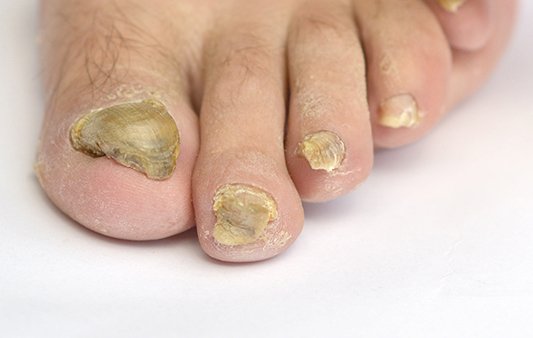
Reducing Your Thickened or Bulky Nails
Onychauxis is the medical term for an overgrowth or thickened nail. It occurs both in toenails and finger nails and is more common as we age.
If you have Onychauxis or thickened nails you’ll notice that the nail is thicker on the upper part. Some people find that the nail becomes white or yellowish and that the nail edges fall apart.
What causes thickened or bulky nails?
We often assume that thick toenails are caused by fungus growing under and within the toenail. This is often correct, however there are other reasons your toenails may be looking thick and distorted.
If you have injured the root of your nail, then it can thicken temporarily. If the injury is severe or repeated, for example if you are a professional footballer, then you might find your nail is permanently distorted.
Psoriasis, poor circulation, and systemic diseases of the body such as diabetes and rheumatoid arthritis can cause thickened nails. Also, as a normal part of ageing we find our nails have a tendency to thicken as they grow.
What problems can thickened or bulky nails cause?
The most common problems you’ll find if you have thickened nails are pain and discomfort when wearing socks and shoes. You’ll also find it increasingly more difficult to cut your toenails uniformly and safely as the nail becomes thicker and more rigid.
What happens if I do nothing about my thickened nails?
If your nails are left untreated the condition can worsen, developing into a condition known as Onychogryphosis (also known as ‘Rams horn nails’). If this happens your nail will become permanently thickened and distorted, resembling claws or a rams horns.
How should I treat my thickened nails?
As a foot health care practitioner we trained in assessing your nails to ascertain the cause of any thickening or discolouration. This means we are able to rule out if you are suffering from a fungal nail infection.
In the case of thickened nails we initially spend time reducing the thickness in a pain-free way. This gives you the benefit of nails that immediately look and feel better.
Most thickened nails do require some type of regular treatment by a foot health practitioner for effective foot care management. With this in mind we assess your thickened nails and would probably recommend regular treatments every 6 – 8 weeks to ensure your nails are kept at a comfortable and manageable length.
Onychauxis is the medical term for an overgrowth or thickened nail. It occurs both in toenails and finger nails and is more common as we age.
If you have Onychauxis or thickened nails you’ll notice that the nail is thicker on the upper part. Some people find that the nail becomes white or yellowish and that the nail edges fall apart.
What causes thickened or bulky nails?
We often assume that thick toenails are caused by fungus growing under and within the toenail. This is often correct, however there are other reasons your toenails may be looking thick and distorted.
If you have injured the root of your nail, then it can thicken temporarily. If the injury is severe or repeated, for example if you are a professional footballer, then you might find your nail is permanently distorted.
Psoriasis, poor circulation, and systemic diseases of the body such as diabetes and rheumatoid arthritis can cause thickened nails. Also, as a normal part of ageing we find our nails have a tendency to thicken as they grow.
What problems can thickened or bulky nails cause?
The most common problems you’ll find if you have thickened nails are pain and discomfort when wearing socks and shoes. You’ll also find it increasingly more difficult to cut your toenails uniformly and safely as the nail becomes thicker and more rigid.
What happens if I do nothing about my thickened nails?
If your nails are left untreated the condition can worsen, developing into a condition known as Onychogryphosis (also known as ‘Rams horn nails’). If this happens your nail will become permanently thickened and distorted, resembling claws or a rams horns.
How should I treat my thickened nails?
As a foot health care practitioner we trained in assessing your nails to ascertain the cause of any thickening or discolouration. This means we are able to rule out if you are suffering from a fungal nail infection.
In the case of thickened nails we initially spend time reducing the thickness in a pain-free way. This gives you the benefit of nails that immediately look and feel better.
Most thickened nails do require some type of regular treatment by a foot health practitioner for effective foot care management. With this in mind we assess your thickened nails and would probably recommend regular treatments every 6 – 8 weeks to ensure your nails are kept at a comfortable and manageable length.






